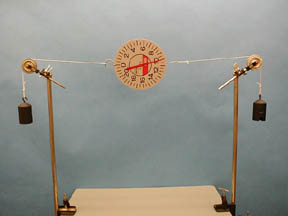Demos: 1J-04 Scale Paradox 1

Two equal weights are attached to the ends of a string which passes over two smooth pulleys. A spring scale is inserted in the string to measure the tension. The scale reading reveals that the tension is equal to only one of the weights, not both.
The common misunderstanding that the scale should read twice the weight arises primarily from not realizing that the scale measures the tension in the cord.
Directions: In setting up the demo, be sure that the scale is covered before the weights are hung so that students don’t see the result before they’re asked to predict.
Suggestions for Presentation: It isn’t difficult to get students to predict the wrong result here. You can be as misleading as you like. In explaining the result, ask the students what the scale would read if the one end of the scale were simply anchored to a wall. Most students will guess correctly in this case. Now show that each weight is just being an “anchor” to the other. E. g., if you couldn’t see how the one end is anchored, the results would be the same and you would have no way of knowing. (Also, you might ask what would be different if one simply poured glue over one of the pulleys. When it hardens, the situation is equivalent to that end being anchored.)
Applications: Here you might want to refer to the Magdeburg Hemispheres experiment done by von Guericke. Two teams of eight horses try to pull the hemispheres apart. But the same force would have been applied if he had used only eight horses and tied the other end to a tree! But not nearly as dramatic!!
Last Updated: Nov 30, 2023 11:25 AM